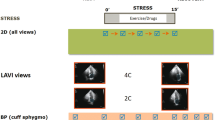Summary
Stress-induced wall motion abnormalities are a sensitive marker of myocardial ischaemia. Stress echocardiography has recently been the subject of increasing interest because of its improved feasibility and compatibility with new and effective alternative stresses. Transoesophageal atrial pacing (TAP) with 2-dimensional echocardiography (2-D echo) is a recently developed echocardiographic stress procedure that has been shown to be reliable and effective in both the diagnosis and evaluation of stress-induced myocardial ischaemia.
TAP with 2-D echo was performed after treatment with placebo and intravenous gallopamil 0.03 mg/kg in 12 patients with stable, reproducible angina of effort. Compared with placebo, gallopamil treatment increased the time to 1mm ST-segment depression (6.6 vs 5.3 minutes; p < 0.05) and improved the ventricular wall motion score at a heart rate of 130 beats/min (17 vs 15; p < 0.01) and 150 beats/min (13 vs 11; p = 0.07). Three patients who developed angina after placebo administration were symptom-free after gallopamil. Thus, gallopamil exerts a beneficial effect on atrial pacing-induced ischaemia, by increasing the pacing time to the ischaemic threshold and reducing the extent of dysfunctional myocardium during ischaemia.
Similar content being viewed by others
References
De Servi S, Ferrario M, Ghio S, Mussini A, Angoli L, et al. Coronary haemodynamic effects of short term intravenous administration of gallopamil in patients with stable exertional angina. British Heart Journal 57: 226–231, 1987
Fleckenstein A, Fleckenstein B, Spah F, Byon YK. Gallopamil (D-600) — a calcium antagonist of high potency and specificity. Effects on the myocardium and pacemakers. In Kaltenbach M, Hopf R (Eds) Gallopamil. Pharmacological and clinical profile of a calcium antagonist, pp. 1–32, Springer-Verlag, Heidelberg, 1984
Iliceto S, D’Ambrosio G, Sorino M, Papa A, Amico A, et al. Comparison of postexercise and transesophageal atrial pacing two-dimensional echocardiography for detection of coronary artery disease. American Journal of Cardiology 57: 547–552, 1986
Iliceto S, Sorino M, D’Ambrosio G, Papa A, Favale S, et al. Detection of coronary artery disease by two-dimensional echocardiography and transesophageal atrial pacing. Journal of the American College of Cardiology 5: 1188–1197, 1985
Khurmi NS, O’Hara MJ, Bowles MJ, Bala Subramanian V, Raftery EB. Randomised double-blind comparison of gallopamil and propranolol in stable angina pectoris. American Journal of Cardiology 53: 684A–688A, 1984
Lagioia R, Scrutinio D, Mangini SG, Caiati C, Mastropasqua F, et al. Efficacia e durata d’azione del gallopamil, in unica somministrazione orale, nell’angina da sforzo stabile. Confronto con propranololo e diltiazem. Cardiologia 31: 377–384, 1986
Mangini SG, Scutinio D, Lagioia R, Mastropasqua F, Caiati C, et al. Placebo-controlled study of gallopamil in the treatment of angina at rest. Current Therapeutic Research 40: 270–276, 1986
Scrutinio D, Iliceto S, Lagioia R, Accettura D, Preziusi N, et al. Treatment of chronic stable angina pectoris with gallopamil. In Bender F, Meesmann (Eds), Steinkopff Verlag, Darmstadt, 1989
Scrutinio D, Lagioia R, Accettura D, Preziusi N, Mastropasqua E, et al. Dose-response effectiveness of gallopamil for the treatment of chronic stable effort angina pectoris: comparison with propranolol. Current Therapeutic Research 37: 830–838, 1985
Thadani U, Lewis JR, Mathew TM, West RO, Parker JO. Reproducibility of clinical and hemodynamic parameters during pacing stress testing in patients with angina pectoris. Circulation 60: 1036–1044, 1979
Tzivoni D, Gottlieb S, Keren A, Benhorin J, Chenzbraun A, et al. Early right atrial pacing after myocardial infarction. I. Comparison with early treadmill testing. American Journal of Cardiology 53: 414–417, 1984a
Tzivoni D, Gottlieb S, Keren A, Benhorin J, Chenzbraun A, et al. Early right atrial pacing after myocardial infarction. II. Results in 77 patients with predischarge angina pectoris, congestive heart failure, or age older than 70 years. American Journal of Cardiology 53: 418–420, 1984b
Tzivoni D, Keren A, Gottlieb S, Granot C, Benhorin J, et al. Right atrial pacing soon after mycoardial infarction. Circulation 65: 330–335, 1982
Author information
Authors and Affiliations
Rights and permissions
About this article
Cite this article
Iliceto, S., Caiati, C., Tota, F. et al. The Importance of Stress-Induced Cardiac Wall Motion Abnormalities in the Evaluation of Drug Intervention. Drugs 43 (Suppl 1), 33–36 (1992). https://doi.org/10.2165/00003495-199200431-00008
Published:
Issue Date:
DOI: https://doi.org/10.2165/00003495-199200431-00008




